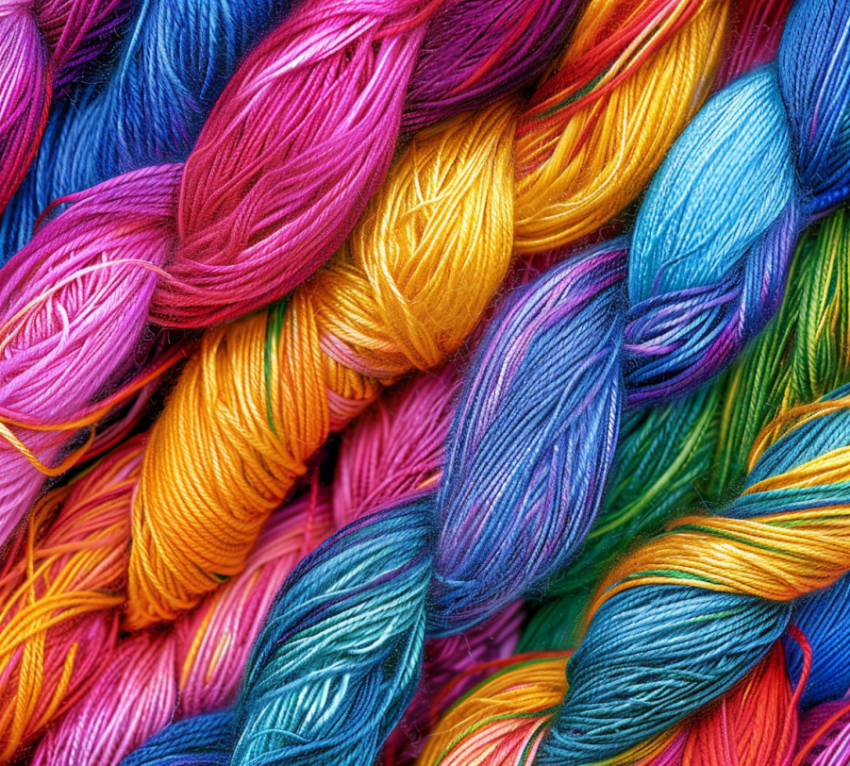











The Building Blocks of Textiles and Fashion - A World of Textures
Fabrics, the flexible materials made from interlaced, interlooped, or bonded fibers or yarns, form the foundation of the textile industry and are essential to countless aspects of human life. From the clothes we wear to the furnishings in our homes, from industrial applications to medical advancements, fabrics provide protection, comfort, decoration, and functionality. Understanding the properties, production methods, and diverse types of fabrics is key to appreciating their significance in our world.
1. Fibers: The Fundamental Units of Fabrics
All fabrics are made up of fibers, which are thin, thread-like strands that can be either natural or synthetic:
- Natural Fibers: Derived from plants or animals.
- Plant-Based:
- Cotton: Soft, absorbent, and breathable.
- Linen: Strong, durable, and cool to the touch, made from flax.
- Hemp: Durable, strong, and naturally resistant to pests.
- Jute: Coarse, strong fiber used for burlap and twine.
- Ramie: Similar to linen, known for its strength and luster.
- Animal-Based:
- Wool: Warm, insulating, and water-repellent, from sheep and other animals.
- Silk: Luxurious, smooth, and strong, produced by silkworms.
- Cashmere: Soft and warm, from the undercoat of cashmere goats.
- Angora: From the fur of Angora rabbits, known for its softness.
- Plant-Based:
- Synthetic Fibers: Created through chemical processes, often from petroleum-based products.
- Polyester: Durable, wrinkle-resistant, and often blended with natural fibers.
- Nylon: Strong, elastic, and abrasion-resistant.
- Acrylic: Soft, warm, and often used as a wool substitute.
- Spandex (Lycra/Elastane): Extremely elastic, providing stretch and recovery.
- Rayon (Viscose, Modal, Lyocell): Semi-synthetic, made from regenerated cellulose, with a soft, drapable quality.
- Acetate: Made from cellulose, known for its silk-like appearance and drape.
2. Yarn: The Intermediate Step
Before most fibers can be made into fabric, they are typically spun into yarn:
- Spinning: The process of twisting fibers together to create a continuous strand of yarn.
- Yarn Properties: Yarn can vary in thickness (weight), texture, and twist, which affect the final fabric's characteristics.
3. Fabric Construction: Weaving, Knitting, and Non-Woven Techniques
Fabrics are constructed using various methods:
- Weaving: Interlacing two sets of yarns (warp and weft) at right angles on a loom.
- Plain Weave: Simplest weave, with each weft yarn going over and under each warp yarn (e.g., muslin, broadcloth).
- Twill Weave: Creates diagonal lines on the fabric surface (e.g., denim, gabardine).
- Satin Weave: Produces a smooth, lustrous surface with a characteristic sheen (e.g., satin, sateen).
- Knitting: Interlooping yarns using needles.
- Weft Knitting: Yarn runs horizontally, creating loops across the width of the fabric (e.g., jersey, rib knit).
- Warp Knitting: Yarn runs vertically, creating loops along the length of the fabric (e.g., tricot, raschel).
- Non-Woven Fabrics: Made by bonding or felting fibers together, without weaving or knitting.
- Felt: Made by matting and pressing wool fibers together.
- Bonded Fabrics: Fibers are bonded together using heat, adhesives, or mechanical processes (e.g., interfacing, some types of artificial leather).
4. Fabric Properties and Performance Characteristics:
Fabrics exhibit a wide range of properties that determine their suitability for various uses:
- Durability: Resistance to wear, tear, and abrasion.
- Strength: Ability to withstand pulling forces (tensile strength).
- Elasticity: Ability to stretch and return to its original shape.
- Absorbency: Capacity to absorb moisture.
- Breathability: Ability to allow air to pass through.
- Water Resistance/Waterproofing: Ability to repel or resist water penetration.
- Wrinkle Resistance: Ability to resist creasing.
- Drape: How a fabric hangs and falls.
- Texture: The surface feel of a fabric (e.g., smooth, rough, soft, crisp).
- Luster: Shininess or sheen.
- Colorfastness: Ability to retain color when exposed to light, washing, or other agents.
- Thermal Properties: Insulation or cooling properties.
5. Finishing Processes: Enhancing Fabric Characteristics
After construction, fabrics often undergo finishing processes:
- Bleaching: Whitening the fabric.
- Dyeing: Adding color.
- Printing: Applying patterns or designs.
- Mercerization: Treating cotton to improve luster, strength, and dye uptake.
- Coating: Applying a layer of another material to add properties like water resistance.
- Calendering: Passing fabric between rollers to create a smooth or glazed surface.
- Sanforizing: A process to reduce shrinkage in fabrics.
6. Fabric Care: Maintaining Appearance and Longevity
Proper care is essential for preserving the appearance and extending the life of fabrics:
- Washing: Follow care label instructions regarding water temperature, washing cycle, and detergent type.
- Drying: Some fabrics can be tumble-dried, while others should be air-dried.
- Ironing: Use the appropriate iron setting for the fabric type.
- Dry Cleaning: Some fabrics require dry cleaning to avoid damage.
- Storage: Store fabrics in a cool, dry place, away from direct sunlight.
7. The Textile Industry: From Fiber to Finished Product
The textile industry is a complex global network that encompasses:
- Fiber Production: Growing and harvesting natural fibers or manufacturing synthetic fibers.
- Yarn Manufacturing: Spinning fibers into yarn.
- Fabric Production: Weaving, knitting, or creating non-woven fabrics.
- Finishing: Dyeing, printing, and applying chemical treatments.
- Garment Manufacturing: Cutting and sewing fabrics into clothing.
- Distribution and Retail: Selling fabrics and finished textile products to consumers.
8. Sustainability and Ethical Concerns in the Fabric Industry
The textile industry faces significant environmental and social challenges:
- Water Pollution: Textile production, particularly dyeing and finishing, can generate large amounts of wastewater containing harmful chemicals.
- Greenhouse Gas Emissions: The industry is a significant contributor to greenhouse gas emissions.
- Waste Generation: Fast fashion and textile waste contribute to landfill problems.
- Labor Practices: Concerns about working conditions and fair wages in some parts of the textile industry.
- Chemical Use: The use of certain chemicals in textile processing can be harmful to human health and the environment.
9. Innovations in Fabric Technology
- Smart Textiles (E-textiles): Fabrics with embedded electronics, sensors, or conductive materials, offering functionalities like health monitoring, communication, and energy harvesting.
- Nanotechnology: Used to create fabrics with enhanced properties like water repellency, stain resistance, and UV protection.
- Biotechnology: Exploring the use of bio-based materials and processes to create more sustainable fabrics.
- 3D Printing: Being used to create custom fabrics and garments.
10. The Future of Fabrics
- The fabric industry is moving towards greater sustainability, with a focus on using recycled and eco-friendly materials, reducing waste, and minimizing environmental impact.
- Technological advancements will continue to drive innovation in fabric design, production, and functionality.
- The demand for high-performance fabrics with specialized properties is expected to grow.
Conclusion:
Fabrics are fundamental to human society, providing us with clothing, shelter, and a vast array of other essential products. The world of fabrics is a diverse and fascinating landscape, encompassing a wide range of natural and synthetic materials, each with its own unique properties and uses. From the luxurious drape of silk to the rugged durability of denim, fabrics shape our everyday experiences and reflect our cultural values. As technology advances and our awareness of environmental and social issues grows, the fabric industry will continue to evolve, striving to create innovative, sustainable, and ethically produced materials that meet the needs of a changing world.
Top Keywords on Google:
Fabrics, types of fabrics, fabric types, natural fabrics, synthetic fabrics, cotton, linen, silk, wool, polyester, nylon, rayon, acrylic, spandex, fabric properties, fabric construction, weaving, knitting, non-woven fabrics, fabric finishes, dyeing, printing, fabric care, textile industry, fashion industry, fabric history, sustainable fabrics, organic fabrics, recycled fabrics, smart textiles, e-textiles, fabric technology, fabric innovation, fabric suppliers, fabric manufacturers, fabric by the yard, buy fabric online, fabric store near me, upholstery fabric, apparel fabric, industrial fabrics.
Industry/Material: Machine (Continued)
37. The Machine: Powering Industry and Transforming Society - A Deeper Look
H1 Title: The Machine: Powering Industry and Transforming Society - Advancements and Impacts
Meta Title: Machines: Further Exploring Types, Mechanisms, Impacts, and Future Trends
Meta Description: Delve deeper into the world of machines! Explore advanced machine types, intricate mechanisms, profound societal impacts, and the exciting future of machine technology.
Content:
(Continued from previous response)
10. Machine Tools: Shaping and Cutting with Precision
Machine tools are power-driven machines used to shape or cut metal or other materials:
- Lathes: Used to rotate a workpiece against a cutting tool, creating cylindrical or conical shapes.
- Milling Machines: Use rotating cutters to remove material from a workpiece, creating a variety of shapes and features.
- Drilling Machines: Used to create holes in materials.
- Grinding Machines: Use abrasive wheels to remove material and achieve precise dimensions and surface finishes.
- Shapers and Planers: Used to create flat surfaces.
- Presses: Used to shape, bend, or punch metal.
- CNC (Computer Numerical Control) Machines: Machine tools that are controlled by a computer, allowing for automated and highly precise machining operations.
11. Engines: The Heart of Many Machines
Engines are machines that convert energy into mechanical work:
- Internal Combustion Engines: Convert the chemical energy of fuel into mechanical energy through combustion within the engine itself. These are commonly used in cars, trucks, and motorcycles.
- Gasoline Engines: Use gasoline as fuel.
- Diesel Engines: Use diesel fuel.
- External Combustion Engines: Convert heat energy from an external source (like burning fuel) into mechanical work. Steam engines are an example.
- Electric Motors: Convert electrical energy into mechanical energy. They are increasingly being used in vehicles and various industrial applications.
- Jet Engines: A type of gas turbine engine that produces thrust by expelling hot gases. Used in aircraft.
- Rocket Engines: Produce thrust by expelling hot gases generated by the combustion of propellants. Used in spacecraft.
12. Hydraulic and Pneumatic Systems: Fluid Power
Hydraulic and pneumatic systems use fluids (liquids or gases) to transmit power and motion:
- Hydraulic Systems: Use incompressible liquids, such as oil, to transmit force. Commonly used in heavy machinery like excavators, cranes, and presses.
- Pneumatic Systems: Use compressed air to transmit force. Often used in power tools, automation systems, and braking systems.
13. The Role of Machines in Different Industries:
Machines are essential in virtually every industry:
- Manufacturing: Machines are used to produce goods of all kinds, from cars and electronics to clothing and food products.
- Agriculture: Tractors, harvesters, and other agricultural machines have revolutionized farming, increasing productivity and efficiency.
- Construction: Excavators, bulldozers, cranes, and other heavy equipment are used to build roads, bridges, buildings, and other infrastructure.
- Transportation: Cars, trucks, trains, airplanes, and ships are all machines that enable the movement of people and goods.
- Mining: Machines are used to extract minerals and other resources from the earth.
- Healthcare: Medical imaging machines, surgical robots, and other medical devices have transformed healthcare.
- Energy: Power plants use turbines and generators to produce electricity.
14. Ergonomics and Human-Machine Interaction:
- Ergonomics is the study of how humans interact with machines and systems. It aims to design machines that are safe, comfortable, and efficient to use.
- Human-machine interaction (HMI) is a field that focuses on the design of interfaces between humans and machines, such as control panels, dashboards, and computer interfaces.
15. Maintenance and Repair: Keeping Machines Running
Machines require regular maintenance and repair to ensure they operate safely and efficiently:
- Preventive Maintenance: Regularly scheduled maintenance tasks, such as lubrication, cleaning, and inspection, to prevent breakdowns.
- Corrective Maintenance: Repairing machines after they have broken down.
- Predictive Maintenance: Using sensors and data analysis to predict when maintenance is needed, allowing for proactive repairs before failures occur.
16. The Impact of Machines on Employment:
The increasing use of machines and automation has raised concerns about job displacement:
- Machines have automated many manual labor jobs, particularly in manufacturing.
- However, machines have also created new jobs in areas such as machine design, programming, maintenance, and repair.
- The impact of machines on employment is a complex issue with ongoing debate among economists and policymakers.
17. Safety and Machines: Minimizing Risks
Working with and around machines can be dangerous, so safety is paramount:
- Machine Guarding: Physical barriers or devices that prevent workers from coming into contact with moving parts.
- Lockout/Tagout Procedures: Procedures for disabling machines during maintenance or repair to prevent accidental startup.
- Safety Training: Workers must be trained on how to operate machines safely and how to identify and avoid hazards.
- Personal Protective Equipment (PPE): Workers may need to wear PPE, such as safety glasses, gloves, and hearing protection, depending on the specific hazards.
18. The Future of Machines: Artificial Intelligence, Robotics, and Beyond
- The development of artificial intelligence (AI) is leading to the creation of increasingly intelligent and autonomous machines.
- Robotics is advancing rapidly, with robots becoming more sophisticated, versatile, and capable of performing a wider range of tasks.
- The Internet of Things (IoT) is connecting machines to each other and to the internet, enabling them to collect and share data, leading to greater automation and efficiency.
- 3D printing and other advanced manufacturing techniques are changing the way machines are designed and built.
- Human-machine collaboration will likely become more common, with humans and machines working together to achieve common goals.
Conclusion:
Machines are an integral part of modern life, powering industries, transforming societies, and extending human capabilities in countless ways. From the simple machines that provide mechanical advantage to the complex and intelligent machines of the digital age, they have revolutionized the way we live and work. As technology continues to advance at an unprecedented pace, machines will undoubtedly play an even greater role in our future, presenting both exciting opportunities and complex challenges that we must navigate thoughtfully and responsibly.
Machine, machines, types of machines, simple machines, complex machines, machine definition, machine history, machine design, machine parts, machine tools, lathe, milling machine, drilling machine, grinding machine, engines, internal combustion engine, electric motor, hydraulic machines, pneumatic machines, automation, robotics, industrial robots, service robots, artificial intelligence, machine learning, machine maintenance, machine repair, machine safety, machine guarding, lockout/tagout, ergonomics, human-machine interaction, industrial revolution, manufacturing, construction machinery, agricultural machinery, transportation

